This spectacular video of a mother Eurasian Lynx and her two young kittens relaxing at Langedrag Wildlife Park in Norway will melt your heart. We thank Johan Naesje for sending us this touching footage, guaranteed to make any cat lover weak with the extreme cuteness.
Jaguarundi photographed in southern Argentina
By Mauro Lucherini
The jaguarundi Puma yagouaroundi is a widely distributed small cat in Latin America. However, its natural history, including its distribution, is still very little understood.
This rare photo, obtained by the GECM (Grupo de Ecología Comportamental de Mamíferos, Universidad Nacional del Sur, Argentina) in southern Buenos Aires province, central Argentina, confirm that jaguarundis are still present, in the southernmost limit of the species geographic distribution range. It is important to mention that this is the only photo of this cat obtained in 384 camera trap stations, which indicates that the jaguarundi is the rarest felid species in the region (where the Geoffroy’s cat, Pampas cat, and puma also occur) and confirms the need for more detailed studies to better assess the conservation status of the species in central Argentina and throughout its range.
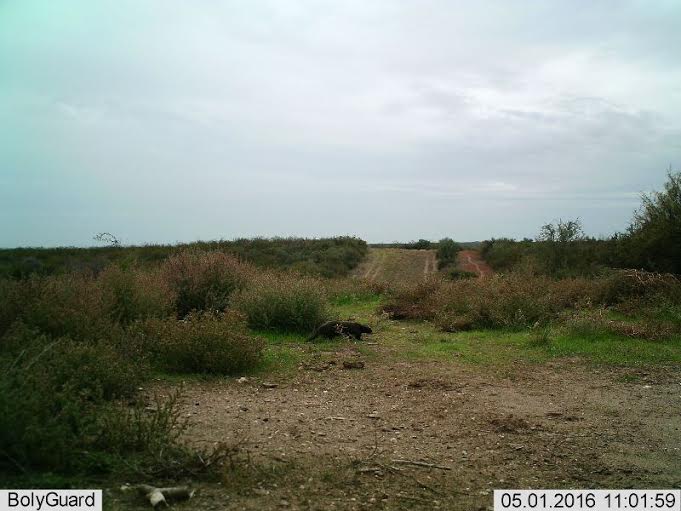
See also
Giordano, A. J. (2016) Ecology and status of the jaguarundi Puma yagouaroundi: a synthesis of existing knowledge. Mammal Review, 46(1), 30-43
Mystery cat requires more conservation and research
Characterization and mitigation of puma-livestock conflicts in central Argentina
Estela Luengos Vidal, M. Guerisoli, N. Caruso, M. Franchini, Z. McDonald, and M. Lucherini
The puma (Puma concolor) is the most widespread top predator and one of the most controversial carnivores in Argentina. It occurs from the high-altitude deserts of the Andes to tropical and subtropical forests, and from the Pampas grasslands to the Patagonian steppe (Nowell and Jackson 1996). The natural prey base of Argentinean puma populations formerly included vicuña, guanaco, Patagonian huemul, taruca, Pampas deer, Marsh deer, rheas, Plain viscachas, Mountain viscachas, Patagonian hare, and capybaras. In the southernmost part of the country large native prey still comprise the bulk of puma diets (Zanón et al. 2012); however, during the last two centuries, hunting of wild prey and conversion of natural habitat into ranches and farms increased conflicts with humans and predation on livestock (Novaro et al. 2000, Walker and Novaro 2010).
This is the case in the southern Espinal where we have been working on carnivore-human conflicts since 2008. Dense shrublands and grasslands of this region have been transformed to create space for livestock. The initial habitat modeling that we performed, based on camera trapping records, show most of the landscape is no longer suitable for pumas (Caruso et al. 2015). A comparison with other carnivores occurring in the region revealed that pumas use sites with moderate fragmentation, but that they prefer preserved areas and avoid sites with significant human presence (Caruso et al. 2016).
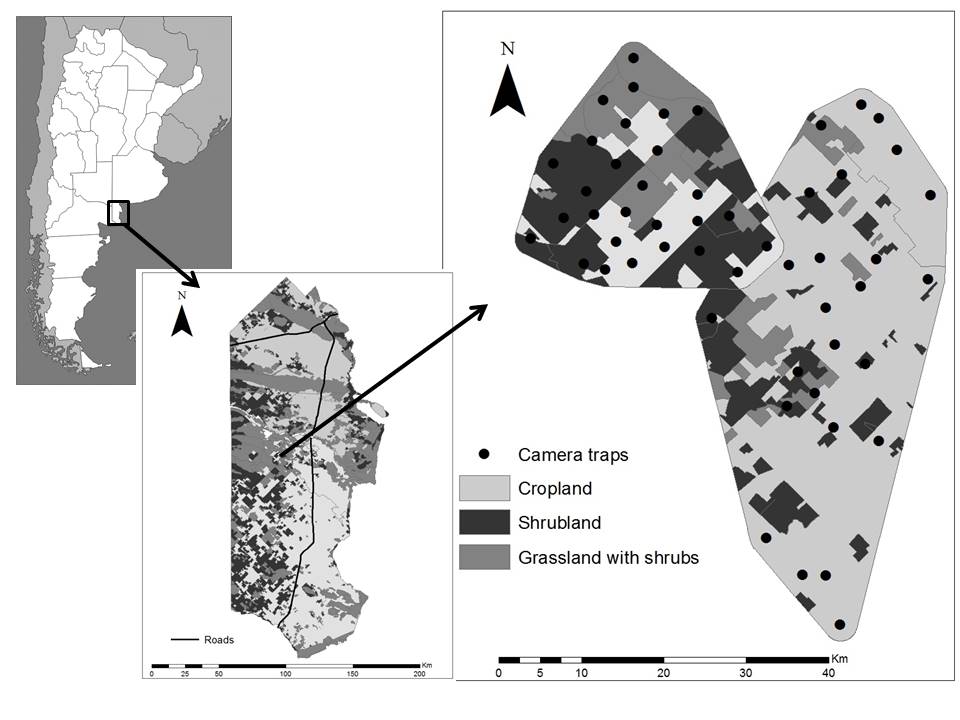
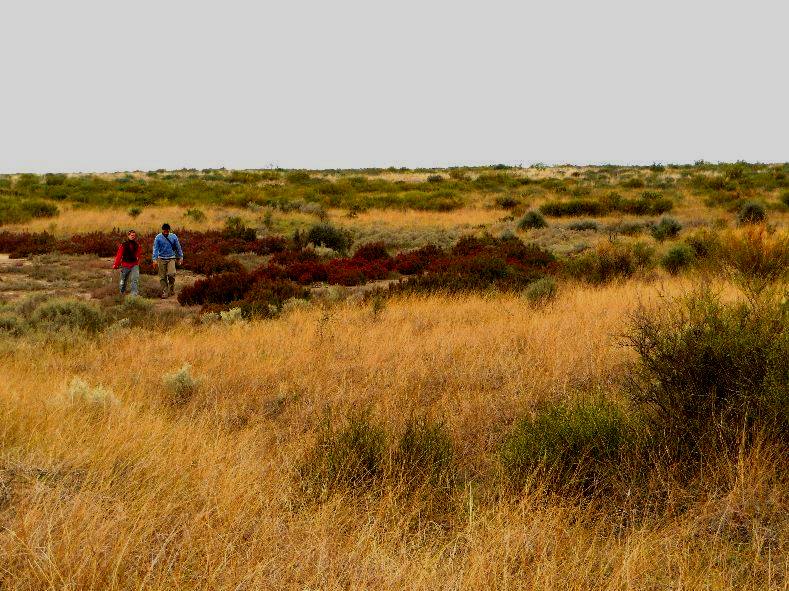
To buttress our previous results and understand the variables affecting habitat use by pumas, we carried out a more intensive camera trapping survey over the last 24 months in two adjacent areas that differed in anthropogenic impact. Capture rates were 67.9% of 28 trapping stations in the area farther from the main road with more natural habitats, while pumas were recorded in 28% of 25 stations located closer to the road, where croplands and pastures prevail.
Interview data (2008-2015) show that sheep were the most predated livestock (7.4 head / year), followed by lambs (2.6 head / year), calves (6 head/year), and foals (0.3 head/year). Based on average prices, the economic losses caused by pumas per ranch per year (USD) were $393 for sheep (range $59-$4713) and $431 for cattle (range $70-$5953). Since sheep provide the primary income in the region, damage caused by pumas is a legitimate concern, so we scrutinized effects of puma predation in more detail. Comparing losses caused by pumas with the numbers of livestock owned, we found that pumas killed 2.2% and 3.9% of the total cattle and sheep, though the proportion individual ranches varied from 2% to 17.8%. We obtained a record of confirmed predation events in a 484-km2 area and found that during 16 months, pumas killed 33 sheep and 4 calves ( 2.23/month or 6.8/ 100 km2).
In the same period, ranchers killed 13 pumas (0.79 pumas / month or 2.7 pumas / 100 km2). This intensity of hunting is not justified by the economic impact of puma predation, and a puma population in the Espinal cannot sustain such a high mortality. The conflicts between pumas and local people are exacerbated by poor response by the government, which does not provide compensation to ranchers affected by puma predation nor provide a forum for their complaints. Predictably, local people see puma hunting as the only solution.
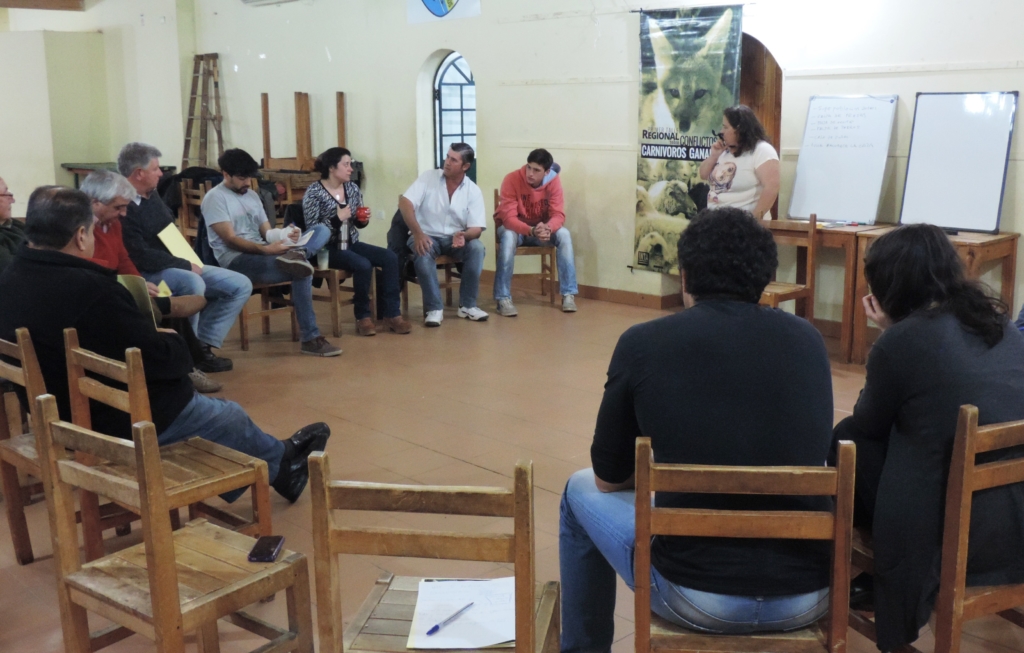
In 2015, we began participatory workshops to further quantify livestock losses and share this information with ranchers, hear ranchers’ positions on the causes of puma predation, and identify, with their help, effective mitigation measures. Analyses of data from the first four workshops indicates that ranchers perceive a widespread intensification in puma predation, and believe that diminished human presence in rural areas is the major cause. Other causes mentioned included presence of shrub land, laws forbidding puma hunting, and poor livestock management.
However, we found that only two of the 12 participants had changed their husbandry, whereas nine (75%) tried to kill pumas. Yet only 3 of the participants killed pumas in the previous year (averaging 3.3 puma per person). Of the 7 ranchers who applied mitigation measures, 6 corralled their livestock at night, 1 used donkeys as guardian animals and 1 reinforced their enclosures. Most participants would try mitigation but requested expert advice, because past attempts had failed or proved uneconomical.
We now plan to test the efficacy of Conditioned Taste Aversion to reduce livestock losses. We will start by testing two substances that have proven effective with other carnivores (Massei et al. 2004; Nielsen et al. 2015). We have started collecting puma tissue and fecal samples to investigate genetic differentiation and gene flow in a meta-population framework.
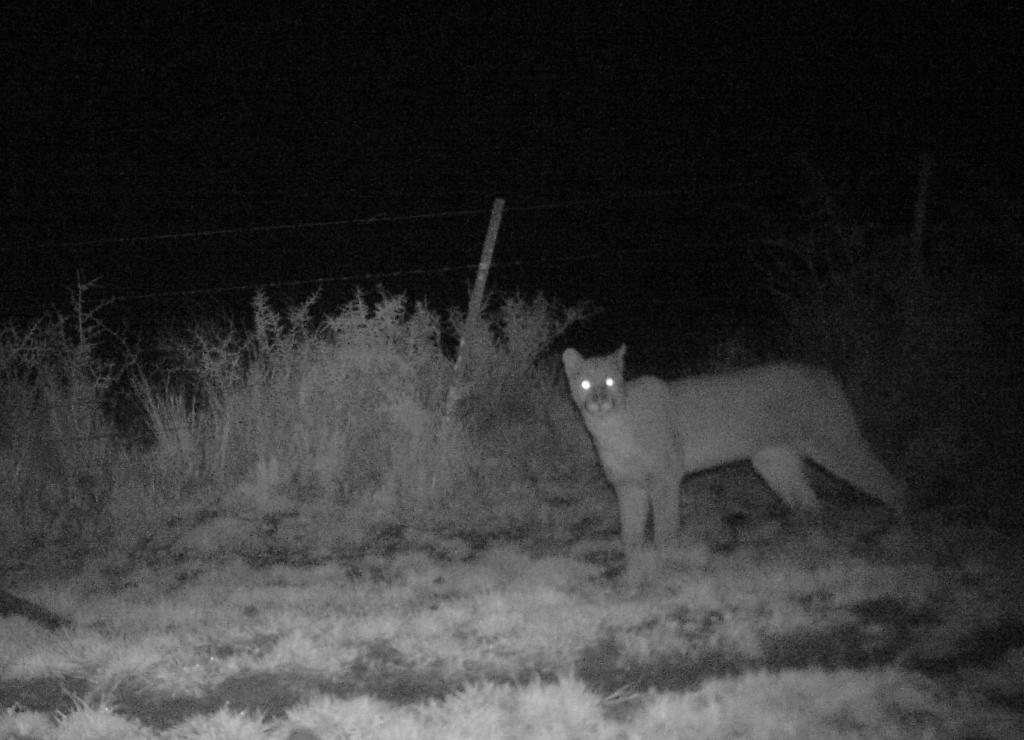
Although puma-livestock conflicts are common throughout Argentina, this is the first attempt to assess their true impact on ranching and the effects of retaliatory killing on puma populations. Our project will provide a baseline without which meaningful management cannot occur. We expect that this project will serve as a pilot experience to reduce livestock predation by pumas and thus provide sound recommendations to mitigate conflict in other areas.
Spectacular Andean Cat Video!
New record on the Andean cat in the province of Jujuy obtained by a group of mammalogists (R. Gonzalez, P. Ortiz, S. d ‘ Hiriart , and P. Jayat ) studying the community of small mammals and highlands in Puno PICT under a project funded by the National Agency for Scientific and Technological Promotion .
Gato andino en la provincia de Jujuy
Nuevo registro sobre el gato andino en la provincia de Jujuy obtenido por un grupo de mastozoólogos (R. González, P. Ortíz, S. d’ Hiriart, y P. Jayat) que estudiaban la comunidad de pequeños mamíferos de zonas puneñas y altoandinas en el marco de un proyecto PICT financiado por la Agencia Nacional de Promoción Científica y Tecnológica.
International conservationists develop a Conservation Strategy for the Fishing Cat
In November 2015, the First International Fishing Cat Conservation Symposium was held in Nepal, hosted in association with the NGOs Himalayan Nature and Small Mammals Conservation and Research Foundation. Participants included representatives from Fishing Cat range countries like Nepal, India, Sri Lanka, Cambodia and Bangladesh, as well as conservationists from USA, UK, Spain and Germany.
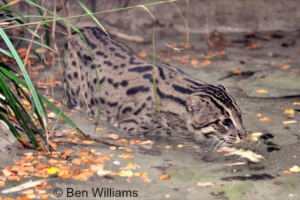 The endangered Fishing Cat Prionailurus viverrinus is at home near water bodies. This unique cat has been known to science since the early 19th century. However, its recent discovery in mangroves along the east coast of India and in Cambodia reveals that still little is known about its distribution and ecological needs. In Asia, wetlands are rapidly being devastated, which results in declining Fishing Cat populations in all range countries.
The endangered Fishing Cat Prionailurus viverrinus is at home near water bodies. This unique cat has been known to science since the early 19th century. However, its recent discovery in mangroves along the east coast of India and in Cambodia reveals that still little is known about its distribution and ecological needs. In Asia, wetlands are rapidly being devastated, which results in declining Fishing Cat populations in all range countries.
Furthermore, they are threatened by killings in retaliation, poaching and traffic. Their status in Pakistan, Myanmar, Thailand, Vietnam and Java is largely unknown. They may have declined dramatically over the last decades.
“This dire perspective across their range motivated us to form the Fishing Cat Working Group in 2011. Our symposium was a huge success. We are the first Working Group who developed a conservation strategy for an Asian small wild cat. Fishing Cats need more targeted conservation efforts to ensure their continued survival in the wild. Our vision is that wild Fishing Cat populations become viable again across their native range, are valued globally and live in harmony with humankind.” said Angie Appel, co-founder and coordinator of the Fishing Cat Working Group.
“In India, they are included in Schedule I of the Wildlife Protection Act, 1 972, along with the tiger, and thus deserve protection measures of the highest accord. Nevertheless, their most important habitats are destroyed by the filling up of wetlands for airports, residential areas and highways due to policy contradictions.” said Tiasa Adhya. She has been engaged in conserving Fishing Cats in West Bengal. Because of her successful efforts she was recently nominated for the Future for Nature award. Giridhar Malla from the Wildlife Institute of India added “A viable population of Fishing Cats was recently recorded in mangroves of Andhra Pradesh. However, oil refineries and expansion of road network pose a huge threat to this population.”
“In Nepal, Fishing Cats have been recorded in protected areas and recently also in human dominated landscapes in the Terai. However, we still don’t know all the specific sites where Fishing Cats are present. Furthermore, they are not listed as a priority protected species in the country.” said Sagar Dahal of the Small Mammals Conservation and Research Foundation.
“Ecological studies on Fishing Cats are scarce even though they live throughout coastal wetlands and hill forests of Sri Lanka.” said Anya Ratnayaka. She radio-collared the first Fishing Cat in suburban Colombo to understand their ecological adaptions to novel urban habitats. “In Sri Lanka, more than 50 individuals died in road accidents during the past two years.” added Ashan Thudugala. In response he installed road signs in the country’s central hills to minimize road accidents involving Fishing Cats.
“In Cambodia, Fishing Cats are poorly studied. Our recent discovery of a Fishing Cat population in mangroves is spectacular. This is not only the first record since 2003, but also in a previously undocumented site.” said Ret Thaung of the Centre for Biodiversity Conservation (CBC) of the Royal University of Phnom Penh. “We are very excited about this discovery because it gives us new hope for the recovery of Fishing Cats in Southeast Asia.” said Vanessa Herranz Muñoz who collaborates with CBC.
“Conservationists in Fishing Cat range countries need to be better linked with the international zoological community for exchange of knowledge. We can increase awareness about the plight of Fishing Cats in the wild and support conservation efforts through fund raising activities.” said Neville Buck of the Aspinall Foundation, UK.
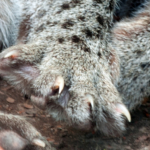 The objectives of the first Conservation Strategy Plan revolve around three major themes, namely ecological, socio-cultural and policy issues. Participants pledged to implement planned activities within the next five years. They will collaborate in developing manuals for policy makers and researchers as well as comprehensive habitat and distribution maps. They will continue to work with local communities and address Fishing Cat conservation needs through advocacy networks. Information material will be created to raise awareness amongst global stakeholders, both young and old.
The objectives of the first Conservation Strategy Plan revolve around three major themes, namely ecological, socio-cultural and policy issues. Participants pledged to implement planned activities within the next five years. They will collaborate in developing manuals for policy makers and researchers as well as comprehensive habitat and distribution maps. They will continue to work with local communities and address Fishing Cat conservation needs through advocacy networks. Information material will be created to raise awareness amongst global stakeholders, both young and old.
The symposium was supported by the Mohamed bin Zayed Species Conservation Fund, the Cincinnati Zoo & Botanical Garden, the Fishing Cat Fund and the Department of National Parks and Wildlife Conservation, Nepal. It was held at Park River View Resort in Nawalparasi close to Chitwan National Park.
–
Information taken from the Proceedings Of the First International Fishing Cat Conservation Symposium held in Nepal last year.
A Win For Bobcats in New Hampshire
 CONCORD, N.H.— The New Hampshire Fish and Game Department today withdrew a proposed administrative rule that would have opened the first bobcat hunting and trapping seasons in the state since 1989. Today’s announcement responds to concerns raised by conservation and animal-protection organizations — including the Center for Biological Diversity and Animal Welfare Institute — that federally protected Canada lynx could be mistakenly shot or ensnared by bobcat hunters and trappers.
CONCORD, N.H.— The New Hampshire Fish and Game Department today withdrew a proposed administrative rule that would have opened the first bobcat hunting and trapping seasons in the state since 1989. Today’s announcement responds to concerns raised by conservation and animal-protection organizations — including the Center for Biological Diversity and Animal Welfare Institute — that federally protected Canada lynx could be mistakenly shot or ensnared by bobcat hunters and trappers.
“We’re so relieved the agency listened to our concerns, and that New Hampshire’s bobcats and lynx are safe from hunters and trappers,” said Collette Adkins, a Center attorney and biologist. “At public expense, these bobcat seasons would have benefited only the few who’d like to kill these beautiful animals for sport or ship their pelts overseas to China for profit. The state heard loud and clear that people value these cats in the wild and don’t want to see them cruelly trapped or shot.”
New Hampshire has protected bobcats since 1989, after decades of hunting and trapping caused the state’s population to plummet to only 200 animals. Under the state’s proposed rule, hunters would have been allowed to chase bobcats with hounds and trappers would have been able to set unlimited numbers of indiscriminate traps that could hurt or kill endangered Canada lynx.
“We are thrilled with the New Hampshire Fish and Game Department’s decision to withdraw its proposal for a bobcat hunting and trapping season, given legal concerns, opposition by many New Hampshire citizens, and the objection from the legislative rules committee,” said Tara Zuardo, a wildlife attorney with the Animal Welfare Institute. “This decision will prevent much animal suffering, allow the state’s bobcat population to continue to recover, and help prevent harm to federally protected Canada lynx.”
On April 1 the New Hampshire Joint Legislative Committee on Administrative Rules voted 9-1 to object to the proposed bobcat hunting and trapping rule. The legislative committee agreed with conservation and animal-protection organizations that the proposal might violate federal law protecting the Canada lynx. Listed as “threatened” under the Endangered Species Act, lynx share the same habitat as bobcat, and the two species of wild cat are very similar in appearance, which could have led to accidental killing of lynx by bobcat hunters and trappers.
Shoot. Shovel. Shut Up.
By Justin Taus
While these may sound like words of wisdom from a mafia movie, they are actually the three steps of a process known as the 3-S treatment and describe the deadly fate of many species of wildlife in rural areas throughout the Americas.
There are a variety of reasons why people resort to the 3-S treatment, including retaliation against an animal that is preying on livestock, or that the presence of an animal classified as endangered restricts a property owner’s land usage. The failure of authorities to consistently respond to people’s demands for assistance in dealing with wildlife conflicts – as well as some countries’ lax enforcement of wildlife protection laws – only serve to amplify the problem.
One certain poultry-targeting ocelot’s life was recently spared in Ecuador, however, thanks to a combined effort on behalf of the Ministry of Environment, a busy rescue and rehabilitation centre called Merazonia, and a farmer who opted for capture and relocation rather than the 3-S treatment. Pending a positive health assessment by Merazonia’s on-site veterinarian, the spotted wild cat would get another chance at life in the wild, not unlike dozens of other animals released by the centre every year.
Founded in 2004, Merazonia’s 250-acre property is located near the village of Mera – one of the gateways to Ecuador’s Oriente region – where the Andean foothills and lush cloud forests progressively give way to the rainforests of the lowland Amazon basin.
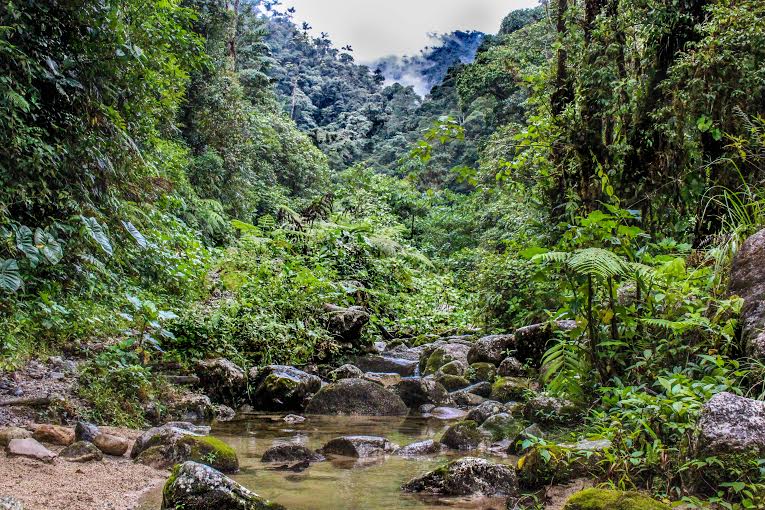
The centre primarily caters to various species of primates, parrots and other mammals. However, it also assists in collecting data on the region’s cat populations and contributes to their conservation in a variety of ways. In 2015, the centre made national news after it managed to capture images of a rare black melanistic jaguar on one its trap cameras on two different occasions. The same camera, located on a trail through dense forest on the centre’s property, has also photographed other jaguars, pumas, oncillas, jaguarundis, margays and ocelots.
The majority of animals brought to Merazonia are rescues from the illegal wildlife trade, as is the case with an adult puma named Pangui who arrived at the centre in 2011. Extremely emaciated, the puma was one of 30 animals confiscated from a hostel in the Andean highlands where it was kept in a small cage as a tourist attraction. Although the centre initially aimed to release Pangui, it became clear that she was just too domesticated to survive in the wild. It is for this reason that she, like a number of other animals at Merazonia, will live out the rest of their lives in the centre’s large enclosures that are designed to resemble their natural habitats.

Nevertheless, like every true rehabilitation centre, their primary focus is to reintegrate animals back to their forest homes whenever possible. Since its inception, Merazonia has released tens of dozens of animals including primates, reptiles, and cats like oncillas, margays and ocelots.
The story of the ocelot patiently awaiting release, however, is particularly inspiring to Frank Weijand, co-founder of Merazonia, who says it is but one of many positive signs of shifting attitudes in local communities in regards to wildlife conservation. Although he recognizes that some people still resort to the 3-S treatment (which makes it difficult to accurately asses the amount of wildlife being killed), it is increasingly common for people to contact Merazonia to ask for assistance in catching and relocating cats spotted near their neighbourhoods, Weijand says. People have also been more inclined to denounce cases of wild animals being illegally held captive as pets and to report injured animals that are found near roads, he adds.
The fact that cats are being increasingly relocated as opposed to killed is due to the hard work of various conservation NGO’s operating in the field combined with an increase in educational television programs that slowly change the way people see and treat wildlife, says Dr. Rafael Hoogesteijn, Jaguar Program special advisor for Panthera, a worldwide wild cat conservation organization.
Nevertheless, the IUCN’s Red List of Threatened Species still mentions retaliatory killing due to depredation of poultry as one of the major threats to ocelots’ declining populations, along with habitat loss and fragmentation and the illegal trade of pets and pelts.

To promote human-wildlife conflict management practices, Panthera runs workshops for ranchers and cattlemen throughout Latin America, and have launched strategy-testing pilot projects on farms in Costa Rica, Belize, Columbia and Brazil. These workshops have been successful in providing communities with low-cost strategies that help prevent predation in the first place. Being proactive, and constantly developing and improving case-specific strategies eliminates the need for people to resort to the dated solution of killing cats or totally eliminating “problem species”, as is still common practice in certain regions of the United States, Argentina and Chile, Hoogesteijn says.
Furthermore, shooting at cats may only worsen livestock predation issues, as Panthera’s studies have found that a high number of “problem cats” had been previously injured by gunshot, causing them to rely on domesticated prey which is much easier to catch and kill, he adds.
In addition to education and outreach programs, an effective feline conservation strategy must also include the establishment of protected areas of adequate size, an increase in monitoring and enforcement of wildlife protection laws, and the need for ranchers to be able to profit from implementing conservation measures on their lands through reward systems, according to Panthera’s Anti-Predation Strategies for Cattle Ranching in Latin America: A Guide. However, Ecuador is one of only three countries throughout the ocelot’s entire range in which they are not protected, according to the IUCN’s Species Survival Commission Cat Specialist Group. This makes the prospects of such a conservation strategy being enacted in the country seem particularly troublesome.
Eventually, the Ministry of Environment completed its paperwork and gave the green light for the ocelot’s relocation in late January 2016. After a quick inspection in the clinic, a team of three Merazonia coordinators set out for the chosen relocation site, Llanganates National Park – a location known to hold healthy populations of cats.

Once on site, the team started their journey into the jungle accompanied by members of the ministry. Coordinators Thomas Ottenhoff, Jason Howard and Jeni Taylor took turns carrying the cat in pairs, aided by a long pole to which the transport cage was attached. After 45 minutes, they encountered a major obstacle – the turbid waters of a fast-flowing river.
It wasn’t until they were half way through the river that they realized the gravity of the situation, as they suddenly stepped into a frigid, waist-deep pool. As the strong current pushed against them they struggled to hold the cage high in the air to avoid submerging the cat as they fought to regain their balance. To make matters worse, the cat had begun to stress, causing her to repeatedly claw at Ottenhoff’s hands, which were just out of reach.
Once on firm ground on the opposing bank, the cat promptly relaxed as it actively sniffed out its new surroundings. Soon after, upon a high ridge, the team opened the cage door and quietly backed off. After a minute or two, the ocelot calmly exited, and within seconds had vanished into the dark forest. Ecstatic, the team gave each other a high-five and stood there for a minute, not speaking, just smiling.
“It was so cool,“ Taylor recalls of the moment every wildlife rehabilitator dreams of, “you can’t top that feeling of watching such a beautiful animal go back to where it belongs.”
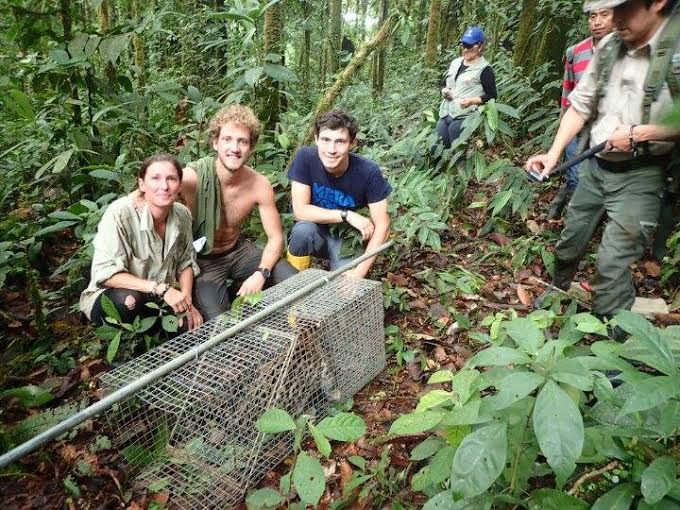
Author Justin Taus can be reached on Twitter @JustinTaus and his Instagram contact is justintaus
Pampas Cat video from northern Peru
These Pampas cat videos were captured by camera traps set in two different wetlands of the Sechura desert in northwestern Perú. They are part of a research project by Alvaro Garcia Olaechea and Cindy Hurtado, entitled “Human-small cat conflict and distribution of the Pampas cat Leopardus colocolo in northwestern Peru and southwestern Ecuador”.
[kad_youtube url=”https://www.youtube.com/watch?v=tJHW5xzB-NU” width=325 height=244 ]
For more information about the project go to Species Conservation.org.
Thank you Alvaro for keeping us updated!
Read more about the Pampas Cat on our fact sheet.
Found! Fishing cat in coastal Cambodia
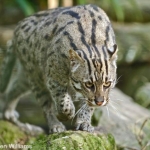 Pictures of the Endangered fishing cat – the first in Cambodia for more than a decade – provide welcome evidence that these elusive felines still survive in some parts of the country.
Pictures of the Endangered fishing cat – the first in Cambodia for more than a decade – provide welcome evidence that these elusive felines still survive in some parts of the country.
Cambodia’s Centre for Biodiversity Conservation (CBC) continues to make history with a camera trap survey revealing that the Endangered fishing cat (Prionailurus viverrinus) can still be found in some parts of the country.
The camera traps have provided the first official records for the species since 2003, capturing images and footage of three individuals at two different coastal sites.
Researchers from the CBC, a partnership between Fauna & Flora International (FFI) and the Royal University of Phnom Penh, were thrilled by the findings which have allayed grave fears about the status of these animals in Cambodia.
FFI project leader, Ms Ret Thaung said that the fishing cat’s preference for wetland habitat had led to severe population declines throughout much of its Asian range. “Asian wetland habitats are rapidly disappearing or being modified by human activity, so fishing cat numbers have declined dramatically over the last decade and the remaining population is thought to be small,” she said.
“Fishing cats are believed to be extinct in Vietnam, no confirmed records in Lao PDR, and with scarce information about the species in Thailand and Cambodia.
“It is clear that urgent steps are needed to protect these cats from snaring and trapping and to conserve their wetland habitats – but to do this effectively we needed to get a better idea of where they live.” “
Overwhelming discovery
The CBC’s camera trap survey was designed to address some of these knowledge gaps . Following leads gathered during interviews with local villagers, the experts set up 32 cameras at five locations and left them to record what passed by .
Sifting through the images, the team was delighted to discover fishing cats at two sites in southwest Cambodia: Peam Krosaop Wildlife Sanctuary (Koh Kong Province) and Ream National Park (Sihanoukville Province).
“This is a remarkable discovery as fishing cats are very vulnerable to human persecution,” Ms Thaung said. “We are especially pleased to see both a male and female cat from Peam Krosaop Wildlife Sanctuary. When working with Endangered species, every animal is important and the excitement of such a discovery is overwhelming.”
As both of these sites are protected areas, the resident fishing cats should be afforded some protection.
Conservation challenges ahead
According to Ms Thaung, the CBC and its partners now aim to develop a fishing cat conservation action plan focused on the two sites where the cats were recorded.
“This will primarily involve community education and measures to reduce threats,” she said. “We also plan to continue our research and improve the ability of local rangers to correctly identify fishing cats and help with research and conservation for the species.”
The main challenge at these two sites will be managing conflicts with people, who have been known to kill fishing cats for their meat or in retaliation for damaging fishers’ nets.
An important facet of any conservation work will therefore be to raise awareness about the species and boost local support for its conservation – particularly in light of recent interviews with villagers living near the two sites, which revealed that local people do not see these animals as important.
Sadly, protected area status alone cannot not guarantee the future of a site or its wildlife, as Ms Thaung explains: “Unfortunately, no cats were found in the freshwater wetlands at the Botum Sakor National Park.”
“We are particularly concerned about this, as this area is being devastated by forest clearance and land degradation.”
Above all, the discovery of fishing cats in two new areas (coupled with their notable absence from a place one might reasonably expect to find them) reveals how much we still have to learn about these animals, and how urgent is the need to protect them.
Fauna & Flora International (FFI) protects threatened species and ecosystems worldwide, choosing solutions that are sustainable, based on sound science and take account of human needs. Operating in more than 40 countries worldwide – mainly in the developing world – FFI saves species from extinction and habitats from destruction, while improving the livelihoods of local people. Founded in 1903, FFI is the world’s longest established international conservation body and a registered charity.
Eurasian Lynx & Cubs Video
This incredible video of a Eurasian lynx and her cubs, taken at Langedrag Wildife Park in Norway, was very generously sent to us by Per Johan Naesje. Thank you so much for sharing!
Learn more about the Eurasian Lynx on our fact sheet.